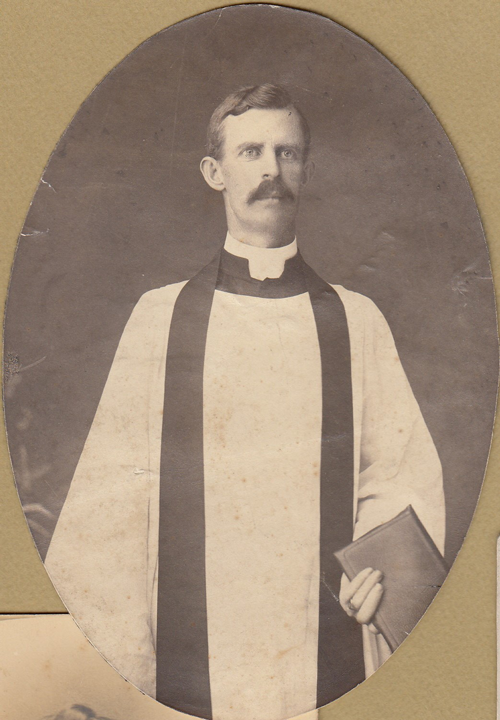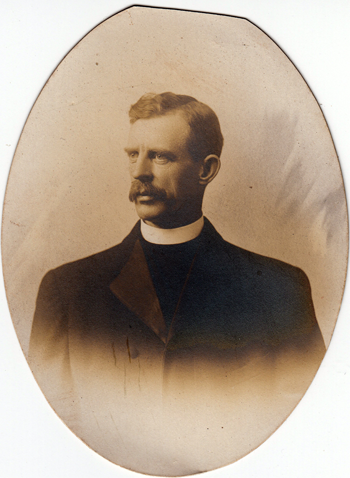
William D. Smith was the rector at St. George’s at the turn of the 20th century having assumed that position as of January, 1897 at the tender age of 34. He was a Virginian from Clarke County in the Shenandoah Valley and took his seminary training at Virginia Theological Seminary. Prior to being called to St. George’s he was rector of St. Paul’s Church near Norfolk
St. George’s was a traditional place at the time. Marshall Hall had been superintendent of Sunday school for 34 years in 1899. Change tended to move at a slow pace. For instance, the Vestry had voted in favor of retaining gas over electricity a decade earlier and in 1890 had purchased eight new gas lights.
Smith had to deal with tight finances at the time. Smith called the Vestry to a meeting two months before Easter 1899 anxious to have the Lenten offerings appropriated to outreach – mission programs. He was opposed by the Chairman of Finances who stressed that the money should be retained internally since “finances of the Church were in such a low state.” The Vestry decided to support the Chairman.
When the Vestry had called Smith in late 1896, Judge Wellington Wallace said the Church could not pay Smith the former rector’s salary of $1,500 “without bringing the Church into debt.” They wanted to pay below $1,300 but realized they couldn’t offer him less than what he had been paid in his former Parish. They compromised on $1,400. (He later received an increase to $1,500 in 1902 as finances temporarily improved.) However, in both 1903 and 1904 deficits appeared toward the end of the year that would require appeals to the parish for greater contributions.
The inside of the Church had suffered in appearance in the late 19th century. In 1894 the Vestry minutes noted “a good deal of the frescoing was pealing off’ of the walls.” Even repair costs seemed difficult to come by. Storm damage in 1896 caused $300 in needed repairs. In the end two members of the Vestry lent the Church funds to cover the repairs. Eventually envelopes were sent to parishioners to contribute directly toward the repayment of the debt.

Still, ways were found to enhance the Church. The women of the Church brought in a new pulpit replacing the existing lectern and a new covering for the communion table. It was likely at this time the back row of pews was removed to provide a walkway between aisles. While excitement was brewing for Easter, the 50th anniversary of the 1849 building would be celebrated on April 24th and reported the next day by the Free Lance-Star.
It was during Smith’s tenure that the cross was removed from the top of the church in 1902 due to the decay of its supports making it “insecure and unsafe.” The Vestry was in favor of simply a spire. (However, a new gilded copper cross was put into place in mid-1909, a gift of John Herndon of Alexandria).
If financial problems were not enough, personnel issues plagued Smith. The organist/choir director submitted her resignation since some of the paid choir members were not only not going to practice but not showing up to sing on Sunday. The Vestry pledged to handle the issue and not accept the resignation though the director later drowned in the Rappahannock. We can only speculate whether it was an accident.
Recently, I have been in contact with Steve W. Baker whose grandmother was Mary Bryson Smith, the fourth of five children by Smith’s first wife. To my knowledge we do not have photos of any of the 19th century rectors. Steve provided both of the ones used in this article.
Smith lived in the rectory at 303 Hanover Street, now a four apartment complex now that also fronts Princess Anne Street. Smith lived on the Hanover Street section. Baker provided a recollection of Christmas, 1903 written by Mary Bryson Smith:
“The four of us standing at the head of the stairs – the stairs went straight down into a long dark front hall. There we stood, before breakfast, Agnes 11, Jack 9 and Bill (he was Will in those days) and I age four waiting for Father to light the candles on the Christmas tree – a live tree and live candles (I never heard of any houses burning down. Then he opened the door to the parlour and we could see the tree in all its splendor. I am sure Mother was with him but she was very much pregnant as Lucy was born on January 10 – That was when the change took place in our lives as mother (Lucy Harrison Powers Smith) died several days after her fourth daughter was born.”
Smith gained some relief from the problems at St George’s and his personal loss in 1904. The Vestry granted Smith take a 3 month leave during 1904 so he could serve several parishes which did not have rectors.
Smith left St. George’s in 1905 and served Christ Church Winchester and then St. Marks, Richmond. Before he left Fredericksburg he married his second wife Elizabeth Coalter Carmichael in December, 2005. Tragically, she died less than a year later in October, 1906 in Winchester. During World War I he served as a chaplain achieving the rank of major. After retiring in 1942 he lived in Winchester and passed away in 1945.
